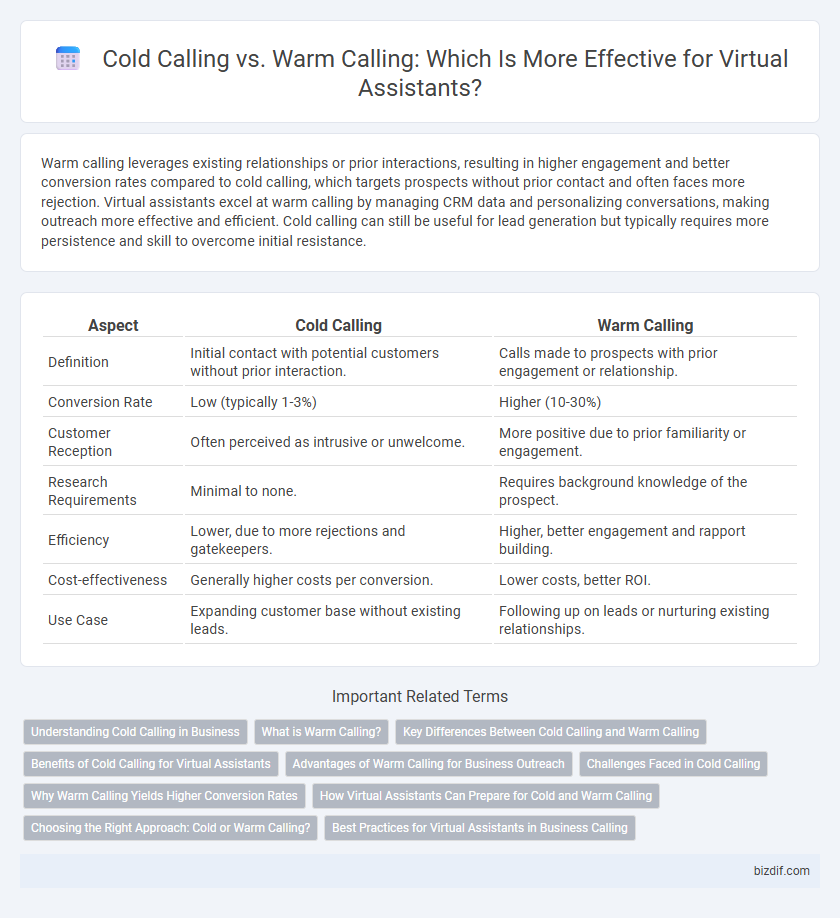Warm calling leverages existing relationships or prior interactions, resulting in higher engagement and better conversion rates compared to cold calling, which targets prospects without prior contact and often faces more rejection. Virtual assistants excel at warm calling by managing CRM data and personalizing conversations, making outreach more effective and efficient. Cold calling can still be useful for lead generation but typically requires more persistence and skill to overcome initial resistance.
Table of Comparison
| Aspect | Cold Calling | Warm Calling |
|---|---|---|
| Definition | Initial contact with potential customers without prior interaction. | Calls made to prospects with prior engagement or relationship. |
| Conversion Rate | Low (typically 1-3%) | Higher (10-30%) |
| Customer Reception | Often perceived as intrusive or unwelcome. | More positive due to prior familiarity or engagement. |
| Research Requirements | Minimal to none. | Requires background knowledge of the prospect. |
| Efficiency | Lower, due to more rejections and gatekeepers. | Higher, better engagement and rapport building. |
| Cost-effectiveness | Generally higher costs per conversion. | Lower costs, better ROI. |
| Use Case | Expanding customer base without existing leads. | Following up on leads or nurturing existing relationships. |
Understanding Cold Calling in Business
Cold calling in business involves reaching out to potential clients or customers without prior contact, aiming to generate new leads from an unfamiliar audience. This technique requires clear scripts and persuasive communication to capture interest despite initial resistance or lack of familiarity. Effective cold calling strategies leverage targeted databases and analytics to identify prospects most likely to convert, maximizing outreach efficiency.
What is Warm Calling?
Warm calling involves reaching out to potential customers who have previously expressed interest or have an existing relationship with your business. This method leverages prior interactions, such as website visits, social media engagement, or referrals, increasing the likelihood of a positive response. Warm calling is highly effective in virtual assistant services as it builds trust and facilitates personalized communication.
Key Differences Between Cold Calling and Warm Calling
Cold calling involves reaching out to potential customers without prior contact, relying on initial pitches to generate interest, while warm calling targets prospects who have previously engaged or shown interest, increasing the likelihood of positive responses. Key differences include the response rate, with warm calling typically achieving higher success due to established rapport, and preparation intensity, as cold calls require more extensive research to overcome objections. Warm calling also benefits from personalization, leveraging past interactions or referrals, whereas cold calling demands broader messaging strategies to capture attention.
Benefits of Cold Calling for Virtual Assistants
Cold calling allows virtual assistants to proactively generate new leads, expanding their client base beyond existing networks. This approach provides valuable opportunities for gaining direct feedback and refining communication strategies in real-time. Virtual assistants benefit from cold calling by building resilience and enhancing their ability to engage diverse prospects effectively.
Advantages of Warm Calling for Business Outreach
Warm calling significantly increases the likelihood of positive engagement by targeting prospects who have already shown interest or interacted with your brand. This approach fosters trust and rapport, leading to higher conversion rates compared to cold calling. Businesses leveraging warm calling experience improved customer retention and more efficient sales processes due to personalized communication.
Challenges Faced in Cold Calling
Cold calling often faces significant challenges such as low response rates and high rejection due to the lack of prior relationship or trust with prospects. The unpredictability of cold calls leads to frequent interruptions and resistance, requiring virtual assistants to develop strong scripts and resilience. Limited information about the prospect can hinder personalized engagement, making it harder to capture interest and qualify leads effectively.
Why Warm Calling Yields Higher Conversion Rates
Warm calling yields higher conversion rates because it targets prospects who have already shown interest or have a prior relationship with the brand, increasing trust and receptiveness. Virtual assistants can leverage CRM data to personalize interactions, making the outreach more relevant and engaging. This personalized approach significantly improves response rates and accelerates the sales funnel compared to cold calling.
How Virtual Assistants Can Prepare for Cold and Warm Calling
Virtual assistants can optimize cold calling by researching target prospects extensively and preparing tailored scripts that address potential pain points, increasing the chances of engagement. For warm calling, virtual assistants should utilize CRM data to personalize conversations, reference previous interactions, and build rapport swiftly. Both approaches benefit from role-playing scenarios and continuous training to refine communication skills and adapt to different client responses.
Choosing the Right Approach: Cold or Warm Calling?
Choosing the right approach between cold calling and warm calling hinges on lead familiarity and engagement levels, as warm calling targets prospects with prior interaction, increasing conversion rates by up to 50%. Cold calling can still be effective for expanding reach to untapped markets but requires a tailored script and persistence to overcome a typical 95% rejection rate. Virtual assistants equipped with CRM insights can seamlessly switch between cold and warm calling strategies, ensuring personalized communication that optimizes sales funnel efficiency.
Best Practices for Virtual Assistants in Business Calling
Cold calling requires virtual assistants to research prospects thoroughly and craft personalized scripts to engage uninterested leads effectively. Warm calling involves leveraging prior interactions or referrals, enhancing trust and increasing conversion rates by building on existing relationships. Best practices for virtual assistants include maintaining a professional tone, using CRM tools to track interactions, and adapting communication strategies based on call responses to maximize business opportunities.
Cold calling vs Warm calling Infographic

 bizdif.com
bizdif.com